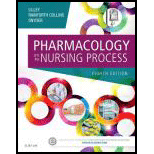
To review:
The function of fluid volume and compartments within the body and the role of major electrolytes in maintaining homeostasis.
Concept introduction:
Fluids in the body are divided into compartments. Fluids within the cell contain dissolved solutes, mostly in the form of electrolytes. The fluids outside the cell play a greater role in transportation of nutrients. Fluid and electrolyte balance are the major factors that help in maintaining homeostasis. This ensures an equal intake and release of fluids.
Explanation of Solution
Fluids in the body are distributed into two main compartments namely intracellular fluid (ICF) and extracellular fluid (ECF). ICF is within the cells, and it dissolves electrolytes and other solutes. ECF is present outside the cells. They help in the transport of nutrients and waste products. ECF can be an interstitial fluid that surrounds the cells or intravascular fluid that refers to the blood in the circulatory system.
The volume of fluids is very important to maintain an essential balance of the body. If more water is lost from the body than it is gained, it results in a condition called dehydration. There are 3 main types of dehydration namely hypertonic, hypotonic, and isotonic. Hypertonic dehydration results when the amount of water lost is greater than the amount of sodium lost. This increases the concentration of solutes outside the cell and causes the cell to shrink by loss of fluid to outside. Hypotonic dehydration occurs when the amount of sodium lost is greater than the amount of water lost. This increases the solute concentration inside the cells and as a result, the solvent is pulled into the cells. Isotonic dehydration occurs due to a decrease in ECF volume by loss of both sodium and water.
The important electrolytes include sodium, potassium, magnesium, calcium, phosphate, chloride, and bicarbonate. Potassium is the major electrolyte in the intracellular fluid, whereas sodium and chloride are the main electrolytes in extracellular fluid. Potassium plays major roles in nerve impulse transmission, contraction of muscles, and heartbeat regulation. Sodium is the most important electrolyte that helps in maintaining acid–base balance, osmotic pressure, and controlling water distribution. Clotting of blood, enzyme reactions, and other homeostatic mechanisms are also controlled by the balancing of electrolytes.
An increase or decrease in the amount of fluids can result in improper functioning of body mechanisms. Thus, fluid balance should be maintained in the body. This is carried out with the help of several electrolytes and solutes.
Want to see more full solutions like this?
Chapter 29 Solutions
Pharmacology and the Nursing Process, 8e
- true or false dark skinned infants should be screened for vitamin D levelsarrow_forwardtrue or false any practice employee is authorized to and should communicate collection guidelines with practice?arrow_forwardrtrue or false equesting a listing of specific creditreferences during patient intake os an acceptable business practice?arrow_forward
- give an overview on the respiratory assessmentarrow_forwardexplain an abdominal exam?arrow_forwardDiscuss β -Lactam antibiotics under the following subheadings Classifications of penicillins Classification of Cephalosporins General Mechanism of Actions Clinical Indications of penicillins and cephalosporins Adverse effects of β-lactamsarrow_forward
- a. Define neoplasm b. Differentiate between benign and malignant tumours c. Describe the molecular basis of cancerarrow_forwarddifferentiate the extra heart sounds S3,S4, murmurs and gallopsarrow_forward• Define shock and list types of shock • Discuss pathogenesis of septic shock. • Enumerate the stages of shock. • Define oedema and describe the pathophysiologic mechanisms of oedema with examples.arrow_forward
- Discuss Hypertension under the following headings: Definition Diagnosis Non-pharmacological intervention Drugs Classification Management of a Hypertensive emergencyarrow_forwardExplain how the answer could be 2 or 1.8 WITHOUT changing the questionarrow_forwardoverview of the neurological system, cranial nerves and what part of the body it innervatesarrow_forward
 Phlebotomy EssentialsNursingISBN:9781451194524Author:Ruth McCall, Cathee M. Tankersley MT(ASCP)Publisher:JONES+BARTLETT PUBLISHERS, INC.
Phlebotomy EssentialsNursingISBN:9781451194524Author:Ruth McCall, Cathee M. Tankersley MT(ASCP)Publisher:JONES+BARTLETT PUBLISHERS, INC. Gould's Pathophysiology for the Health Profession...NursingISBN:9780323414425Author:Robert J Hubert BSPublisher:Saunders
Gould's Pathophysiology for the Health Profession...NursingISBN:9780323414425Author:Robert J Hubert BSPublisher:Saunders Fundamentals Of NursingNursingISBN:9781496362179Author:Taylor, Carol (carol R.), LYNN, Pamela (pamela Barbara), Bartlett, Jennifer L.Publisher:Wolters Kluwer,
Fundamentals Of NursingNursingISBN:9781496362179Author:Taylor, Carol (carol R.), LYNN, Pamela (pamela Barbara), Bartlett, Jennifer L.Publisher:Wolters Kluwer, Fundamentals of Nursing, 9eNursingISBN:9780323327404Author:Patricia A. Potter RN MSN PhD FAAN, Anne Griffin Perry RN EdD FAAN, Patricia Stockert RN BSN MS PhD, Amy Hall RN BSN MS PhD CNEPublisher:Elsevier Science
Fundamentals of Nursing, 9eNursingISBN:9780323327404Author:Patricia A. Potter RN MSN PhD FAAN, Anne Griffin Perry RN EdD FAAN, Patricia Stockert RN BSN MS PhD, Amy Hall RN BSN MS PhD CNEPublisher:Elsevier Science Study Guide for Gould's Pathophysiology for the H...NursingISBN:9780323414142Author:Hubert BS, Robert J; VanMeter PhD, Karin C.Publisher:Saunders
Study Guide for Gould's Pathophysiology for the H...NursingISBN:9780323414142Author:Hubert BS, Robert J; VanMeter PhD, Karin C.Publisher:Saunders Issues and Ethics in the Helping Professions (Min...NursingISBN:9781337406291Author:Gerald Corey, Marianne Schneider Corey, Cindy CoreyPublisher:Cengage Learning
Issues and Ethics in the Helping Professions (Min...NursingISBN:9781337406291Author:Gerald Corey, Marianne Schneider Corey, Cindy CoreyPublisher:Cengage Learning





